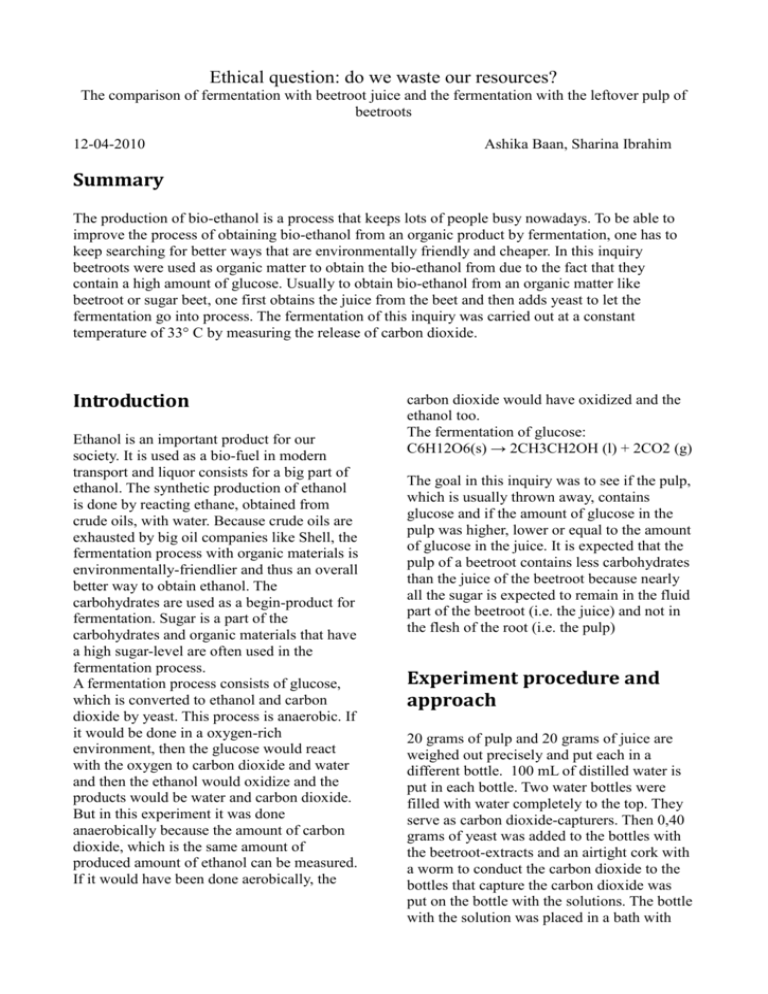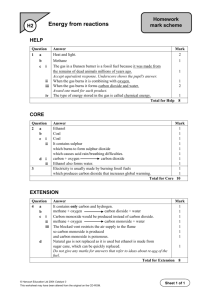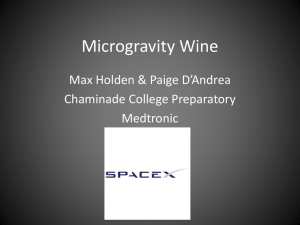Summary
advertisement

Ethical question: do we waste our resources? The comparison of fermentation with beetroot juice and the fermentation with the leftover pulp of beetroots 12-04-2010 Ashika Baan, Sharina Ibrahim Summary The production of bio-ethanol is a process that keeps lots of people busy nowadays. To be able to improve the process of obtaining bio-ethanol from an organic product by fermentation, one has to keep searching for better ways that are environmentally friendly and cheaper. In this inquiry beetroots were used as organic matter to obtain the bio-ethanol from due to the fact that they contain a high amount of glucose. Usually to obtain bio-ethanol from an organic matter like beetroot or sugar beet, one first obtains the juice from the beet and then adds yeast to let the fermentation go into process. The fermentation of this inquiry was carried out at a constant temperature of 33° C by measuring the release of carbon dioxide. Introduction Ethanol is an important product for our society. It is used as a bio-fuel in modern transport and liquor consists for a big part of ethanol. The synthetic production of ethanol is done by reacting ethane, obtained from crude oils, with water. Because crude oils are exhausted by big oil companies like Shell, the fermentation process with organic materials is environmentally-friendlier and thus an overall better way to obtain ethanol. The carbohydrates are used as a begin-product for fermentation. Sugar is a part of the carbohydrates and organic materials that have a high sugar-level are often used in the fermentation process. A fermentation process consists of glucose, which is converted to ethanol and carbon dioxide by yeast. This process is anaerobic. If it would be done in a oxygen-rich environment, then the glucose would react with the oxygen to carbon dioxide and water and then the ethanol would oxidize and the products would be water and carbon dioxide. But in this experiment it was done anaerobically because the amount of carbon dioxide, which is the same amount of produced amount of ethanol can be measured. If it would have been done aerobically, the carbon dioxide would have oxidized and the ethanol too. The fermentation of glucose: C6H12O6(s) → 2CH3CH2OH (l) + 2CO2 (g) The goal in this inquiry was to see if the pulp, which is usually thrown away, contains glucose and if the amount of glucose in the pulp was higher, lower or equal to the amount of glucose in the juice. It is expected that the pulp of a beetroot contains less carbohydrates than the juice of the beetroot because nearly all the sugar is expected to remain in the fluid part of the beetroot (i.e. the juice) and not in the flesh of the root (i.e. the pulp) Experiment procedure and approach 20 grams of pulp and 20 grams of juice are weighed out precisely and put each in a different bottle. 100 mL of distilled water is put in each bottle. Two water bottles were filled with water completely to the top. They serve as carbon dioxide-capturers. Then 0,40 grams of yeast was added to the bottles with the beetroot-extracts and an airtight cork with a worm to conduct the carbon dioxide to the bottles that capture the carbon dioxide was put on the bottle with the solutions. The bottle with the solution was placed in a bath with Ethical question: do we waste our resources? Juice ( quantity of CO2 in mol) Pulp (quantity of CO2 in mol) Measurement 1 4,16 6,07 Measurement 2 3,36 5,80 Figure 2: The setup of the experiment Measurement 3 3,49 5,80 water at a temperature of 33° C. The setup stayed in the bath for two days. After two days the bottles that captured the carbon dioxide were weighed and the difference in masses within each set of bottles after and before fermentation were calculated by subtracting the amount before and after. The setup is presented as figure 2. The results are presented graphically in the following figures. Table 2: release of CO2 in mol The values displayed in Table 2 were calculated by dividing all the values of Table 1 by 44,01, which is the molar mass of carbon dioxide. Table 2 thus represents all the quantities of carbon dioxide in the chemical unit: mol. It is a better way to display the quantities because the amount of produced carbon dioxide is equal to the amount of produced ethanol. Results Data analysis 7 6 Juice ( quantity of CO2 in g) Pulp (quantity of CO2 in g) Measurement 1 183,27 267,23 2 Measurement 2 147,78 255,09 0 Measurement 3 153,75 255,38 Table 1: release of CO2 in grams The values displayed in Table 1 were calculated by subtracting the mass of the water-bottle with the captured carbon dioxide from the mass of the water bottle before the fermentation took place. This was done by weighing the bottles before and after the fermentation with a very accurate weighingscale. Ashika Baan, Sharina Ibrahim 5 mol 4 Juice 3 Pulp 1 Measurement 1 Measurement 2 Measurement 3 Figure 1: the results of the release of carbon dioxide in mol Conclusion and discussion During the observations it was clear that carbon dioxide was arising and that it was conducted to the bottle. This is of course the carbon dioxide-gas that was produced by the yeast cells. A conclusion can be taken that the cells were active and that the glucose in the beetroots was converted to ethanol and carbon dioxide in equal amounts. Page 2 Ethical question: do we waste our resources? The results from Figure 1 show that the amount of released carbon dioxide gas of the pulp is bigger than the amount of released carbon dioxide-gas of the juice. One can deduce that the pulp, which is thrown away in factories, there usually is a high amount of glucose that can be converted to ethanol. The factories don’t use their resources properly if they throw the pulp away. The bigger amount of carbon dioxide produced by the pulp can be explained because the degree of distribution is bigger and the reaction can be passed easier. According to the “colliding particles-model” the bigger the surface, the more space to collide and thus more chance for the reaction to take place. The yeast could easily react with the glucose from the beetroot. The colliding particles-model also embraces that when the concentration is higher, the chance of effective collisions also increases. The concentration of the beetroot juice-solution could be lower than the degree of distribution of the pulp (the degree of distribution is the concentration for a solid matter). The amount of glucose in the pulp is bigger than the amount of glucose in the juice. Due to this assumption the hypothesis can be rejected, because it was assumed that the concentration of the pulp would be lower than that of the juice. Evaluation During our inquiry all the experiments were performed as accurate as possible. The dependant and independent variables were kept constant as much as possible. Though it can be assumed that some things were not very accurate. The juice of the beetroot became thick and slimy after three days, it was nearly impossible to weigh it precisely. Despite this fact the juice was still used for the experiment. This could’ve had a bad influence on the results. The thickened juice couldn’t dissolve very easily in water and that could’ve had an effect on the reaction and the amount of the produced carbon dioxide and ethanol. The control-variables also have a significant role in the inaccuracy of the experiment. The bottles which captured the carbon dioxide Ashika Baan, Sharina Ibrahim were sealed with a cap after the fermentation process. This had to happen under water and it is possible that some carbon dioxide gas escaped. This also makes sire that the results aren’t hundred percent accurate. To improve the degree of accuracy, fresh juice and pulp could be used each time a measurement was taken. That makes sure every measurement is pure, but it also complicates the matter, because different beetroots have to be used and they may carry different gens or have mutations We can conclude that we (as a team doing this inquiry) For a follow-up study one could inquire if the peel of the beetroot contains more or less glucose and if it can be missed because the peel usually contains the most impurities and mutations. Bibliography 1. http://nl.wikipedia.org/wiki/Ethanol 2. http://nl.wikipedia.org/wiki/Rode_biet 3. http://www.voedingswaardetabel.nl/vo edingswaarde/voedingsmiddel/?id=79 9 4. http://www.suikerinfo.nl/allesoversuik er/van_biet_tot_suiker.html 5. http://www.twanetwerk.nl/default.ashx ?DocumentId=2213 Page 3









